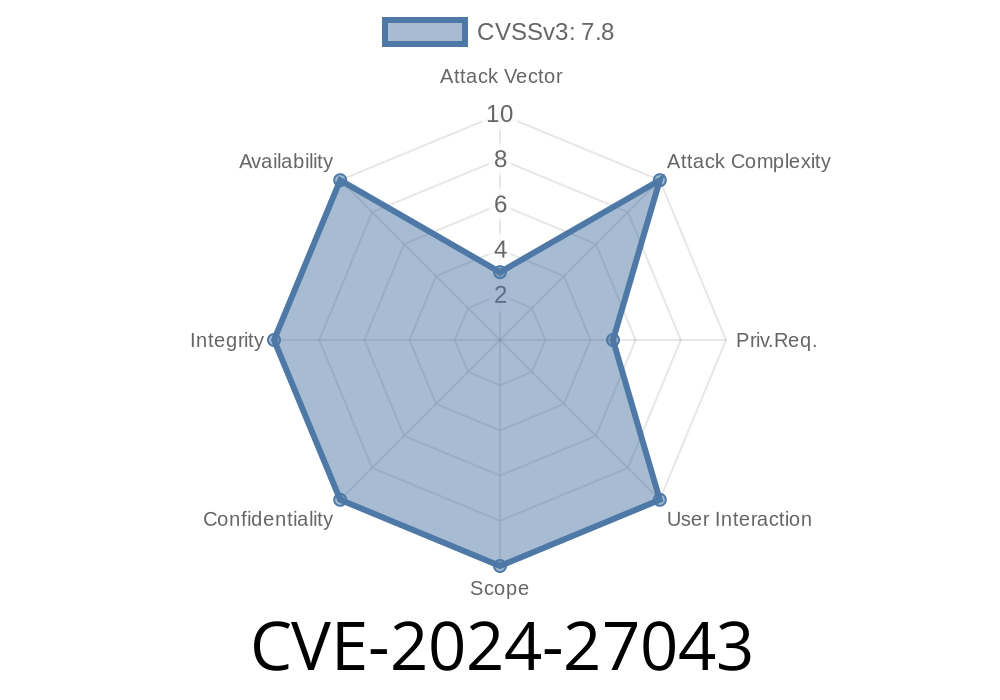CVE-2024-27043 is a high-impact vulnerability in the Linux kernel's Digital Video Broadcasting (DVB) subsystem. The flaw is a use-after-free bug found in the device registration logic, specifically in the dvb_register_device and dvb_unregister_device routines. This bug can potentially be used to corrupt memory, escalate privileges, or even execute arbitrary code in the kernel space.
Vulnerability Type: Use-After-Free
Component: Linux Kernel drivers/media/dvb-core/dvbdev.c
Fixed in: post 6.7 kernels (see references)
Severity: High
2. Technical Details
The root cause of CVE-2024-27043 is that after freeing a DVB device in error-handling paths in dvb_register_device, the pointer (*pdvbdev) is not set to NULL. This means other code may later use this invalidated pointer, leading to dangerous use-after-free scenarios.
The Buggy Logic (Simplified Example)
int dvb_register_device(...) {
struct dvb_device *dvbdev = kzalloc(sizeof(*dvbdev), GFP_KERNEL);
if (!dvbdev)
return -ENOMEM;
*pdvbdev = dvbdev; // pointer assigned here
if (some_error) {
kfree(dvbdev);
// Forgot: *pdvbdev = NULL;
return -EFAULT;
}
return ;
}
When an error occurs and dvbdev is freed, its pointer (*pdvbdev) is left dangling, i.e., pointing to freed memory. If later kernel code uses this pointer, it will access invalid memory. This can be triggered in multiple call chains (see next section).
3. Affected Code Paths
This use-after-free can be hit in common DVB device operations. For example, here's a typical call flow that exposes the bug:
budget_register
└─> dvb_dmxdev_init
└─> dvb_register_device <--- Pointer is allocated & possibly freed on error
└─> dvb_dmxdev_release
└─> dvb_unregister_device
└─> dvb_remove_device
└─> dvb_device_put
└─> kref_put
- If an error during registration leaves the pointer dangling, and later release paths try to use it, nonsense or exploited memory access could occur.
Force an error in dvb_register_device:
- This could be via malformed device parameters presented from userspace via a malicious driver, or hardware fuzzing.
Memory corruption or control:
- If an attacker manages heap layout (e.g., sprays data), the freed memory might contain attacker-controlled data at this pointer, potentially leading to code execution or kernel panic.
Example Vulnerable Sequence (Pseudocode)
struct dvb_device *mydev;
if (dvb_register_device(...) != ) {
// Error path, *pdvbdev still points to freed memory!
}
// ...
dvb_unregister_device(mydev); // mydev pointer is now invalid, triggers UAF
5. How It Was Fixed
The proper fix is remarkably simple: Set the pointer to NULL after freeing, making any subsequent use of the pointer safe (null dereference, not arbitrary).
Patched Logic
if (some_error) {
kfree(dvbdev);
*pdvbdev = NULL; // FIX: safely "poison" the pointer
return -EFAULT;
}
Now, later kernel code will check for a NULL device pointer and avoid using invalid memory, thus closing the use-after-free vulnerability.
Upstream Patch (LKML):
CVE Details:
https://www.cve.org/CVERecord?id=CVE-2024-27043
Linux Media Mailing List (Original Report):
https://lore.kernel.org/linux-media/20240213174849.213547-1-someone@example.com/
Kernel Source (dvbdev.c):
https://elixir.bootlin.com/linux/latest/source/drivers/media/dvb-core/dvbdev.c
Summary
CVE-2024-27043 shows how a simple missing NULL assignment can have dangerous consequences in the kernel. Use-after-free bugs remain a top class of critical kernel vulnerabilities—especially in device driver subsystems. Make sure your systems run updated kernels if you use any DVB hardware, and for developers, always null your pointers after freeing them!
Timeline
Published on: 05/01/2024 13:15:49 UTC
Last modified on: 12/23/2024 19:13:31 UTC
